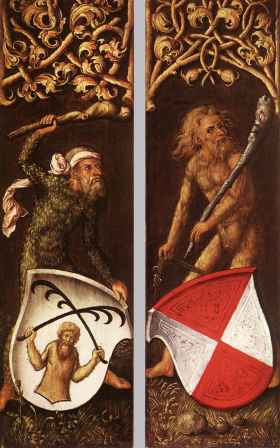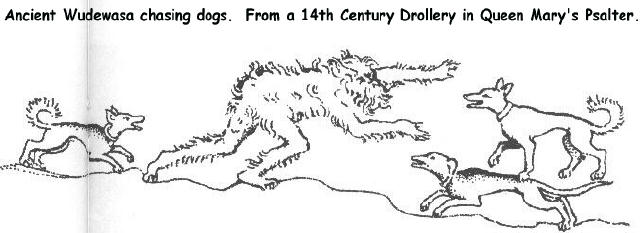Bigfoot Encounters
The Wudewasa - Woodwose, Wudewose - Wudéwásá
Wudewasa, Woodwose,
Wodewoses,
Woodhouses,
Wudu (Ancient Anglo-Saxon),
Wudéwásá,
Wuduwasa,
and Wudewas are the many names to come out of the historical document in the UK.
 The Woodwose (Anglo-Saxon: wuduwasa) or hairy wildman of the woods was the Sasquatch figure of medieval Europe. Images of woodwoses appear in the carved and painted roof bosses where intersecting ogee vaults meet in the cathedral of Canterbury, in positions where one is also likely to encounter the vegetal Green Man. The woodwose, pilosus or "hairy all over", and often armed with a club, was a link between civilized humans and the dangerous elf-like spirits of natural woodland, such as Puck.
The Woodwose (Anglo-Saxon: wuduwasa) or hairy wildman of the woods was the Sasquatch figure of medieval Europe. Images of woodwoses appear in the carved and painted roof bosses where intersecting ogee vaults meet in the cathedral of Canterbury, in positions where one is also likely to encounter the vegetal Green Man. The woodwose, pilosus or "hairy all over", and often armed with a club, was a link between civilized humans and the dangerous elf-like spirits of natural woodland, such as Puck.
The image of the wild man survived to appear as supporter for heraldic coats-of-arms, especially in Germany, well into the 16th century. Early engravers in Germany and Italy were especially fond of wild men, wild women, and wild families, with examples from Martin Schongauer, Albrecht Dürer, and Giovanni Battista Palumba, among others.
Then they was this definition:
Old Anglo-Saxon name, from a 14th century English Bestiary. Meaning: "Wood-Man".
From it are believed to derive the English surnames Woodhouse and Wodehouse,
via the forms: Wodwos; Wodewese; Wodewose; Wodwose; Woodwose. (Odette Tchernine)
The name 'wodewose' is derived from the Anglo-Saxon Wudewasa and thence from Wudu (late Old English for a wood); Wudewasa to mean 'man-of-the-wood', although it can also mean 'savage', 'satyr', and 'faun' and later on, was used as well for anyone dressed like a wildman in a play or pageant.
Wildmen are important figures in medieval paintings and illuminated manuscripts. They may be called 'wodewoses' or 'woodhouses', and are frequently shown covered with long hair or fur. An additional class of picture shows actors in plays, masques and dramas who are depicted in wildman costumes. A recent survey of wildman representations from the eighth to the 16th centuries produced many examples, which mirror the way in which the wildman is portrayed in literature. Although apes and monkeys can be clearly distinguished as well as wildmen, it is not possible to identify other varieties of primate.
Ivan Sanderson believed
that after the 16th century the memory of genuine (hominid) early wodewoses
became indistinct and that much confusion existed between this folk memory
and accounts of newly discovered primates in the tropics. However, wodewoses
were still to be found in Europe until the 15th century, and there is
a vivid example of a hairy wildman attacking (and being attacked by) dogs
in the 14th-century Queen Mary's Psalter now in the British Library

It could be that wodewoses are a continuation of the classical satyr mythology. The fact that representations of them change over time merely indicates changes in the role of the wildman within the culture that had grown up around him, not a progression from an original prototype post-Roman wodewose whose representations became increasingly degenerate.
Ivan T. Sanderson went on to also pen a report in which he discusses the Wudewasa, or hairy Primitives of Ancient Europe. Descriptions of these Wudewasa, or simply Wild men, indicate they are covered with long hair or fur, and are quite distinct from apes or monkeys. A late 15th century bestiary (Hemingham Hall) has a representation of one of these creatures holding a snake in his right hand and a rough club in his left hand, and the feet hairless, while the rest of the body has long curly hair with a generous mustache and beard."
Sanderson continues, "The crude clubs carried by the Wudewasa types are invariably of the same form and size, and are nearly always carried in the left hand, even if the right is free. But even more convincing than this detail is the care with which they depict the feet of each of the creatures, (there being) greater significance than any other anatomical detail in distinguishing between hominid and pongid anthropoids. Also, the clubs carried by the Wudewasa's are deliberately and carefully shown to be but crude logs with rounded ends and of somewhat lesser diameter at the end held by the hands; the weapons and tools alleged to have been also carried by various Abominable Snowmen.
After reviewing hundreds of reports by those persons who say they have observed these various creatures, it seems nobody claimed they ever carried anything made of other than wood; while, of wooden objects, we have constant reference to crude clubs, and primitive bows and arrows...subhominids, in tearing green branches from trees, came upon bark-strips and thus the string for the bow and subsequently simple weaving at a very early period when they were still wet-forest denizens.
Notice that in the Americas, it is estimated that natives started using the bow some 4000 years ago, prior to that using an atlatl, or spear thrower.
I also, recall that
in the Albert Ostman kidnapping, the creatures had woven a blanket of
sorts, stuffed with ferns. Many researchers feel that the European Wild
Men might be relict Neanderthals; indeed, Dr. Myra Shackley addresses
this problem in her 1983 book, "Still Living-Yeti Sasquatch and
the Neanderthal Enigma" and Ivan Sanderson, back in 1967 in
his article: "The Hairy Primitives of Ancient Europe."
Back to Creatures?
Back to What's New?
Back to Newspaper & Magazine Articles?
Home/Main
- ---
Portions of this website are reprinted under the Fair Use Doctrine of International Copyright Law as educational material without benefit of financial gain. This proviso is applicable throughout the entire website at www.bigfootencounters.com